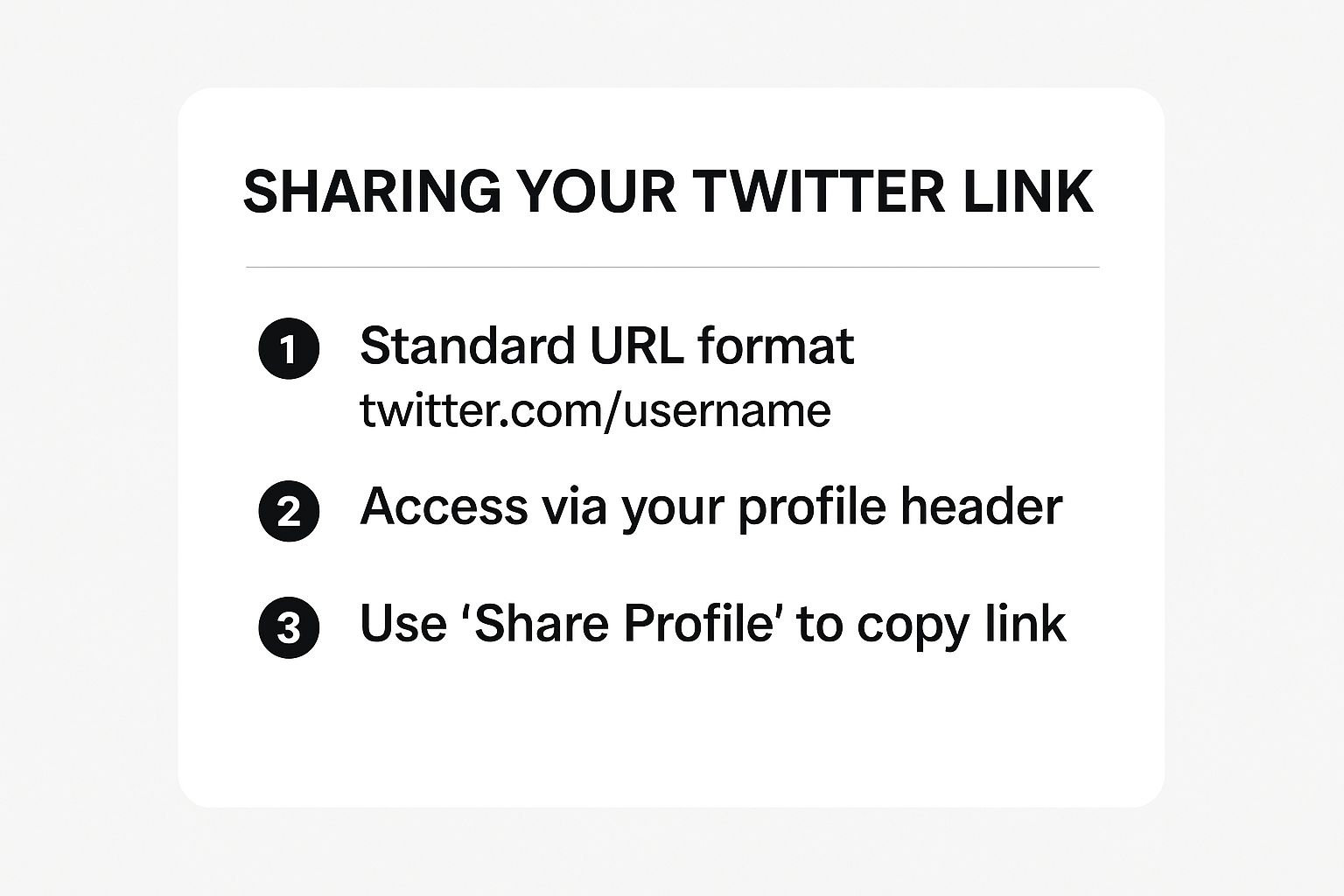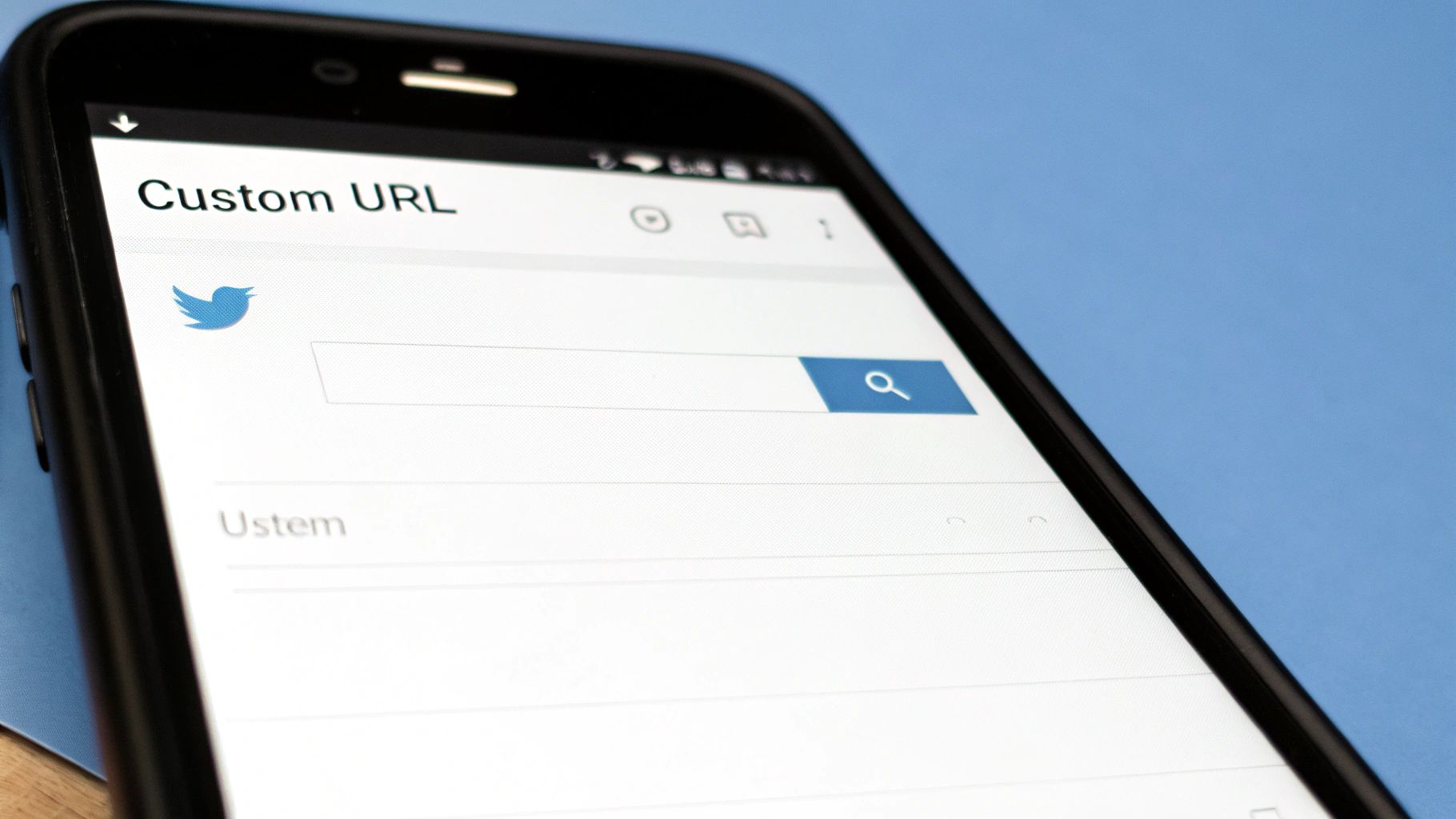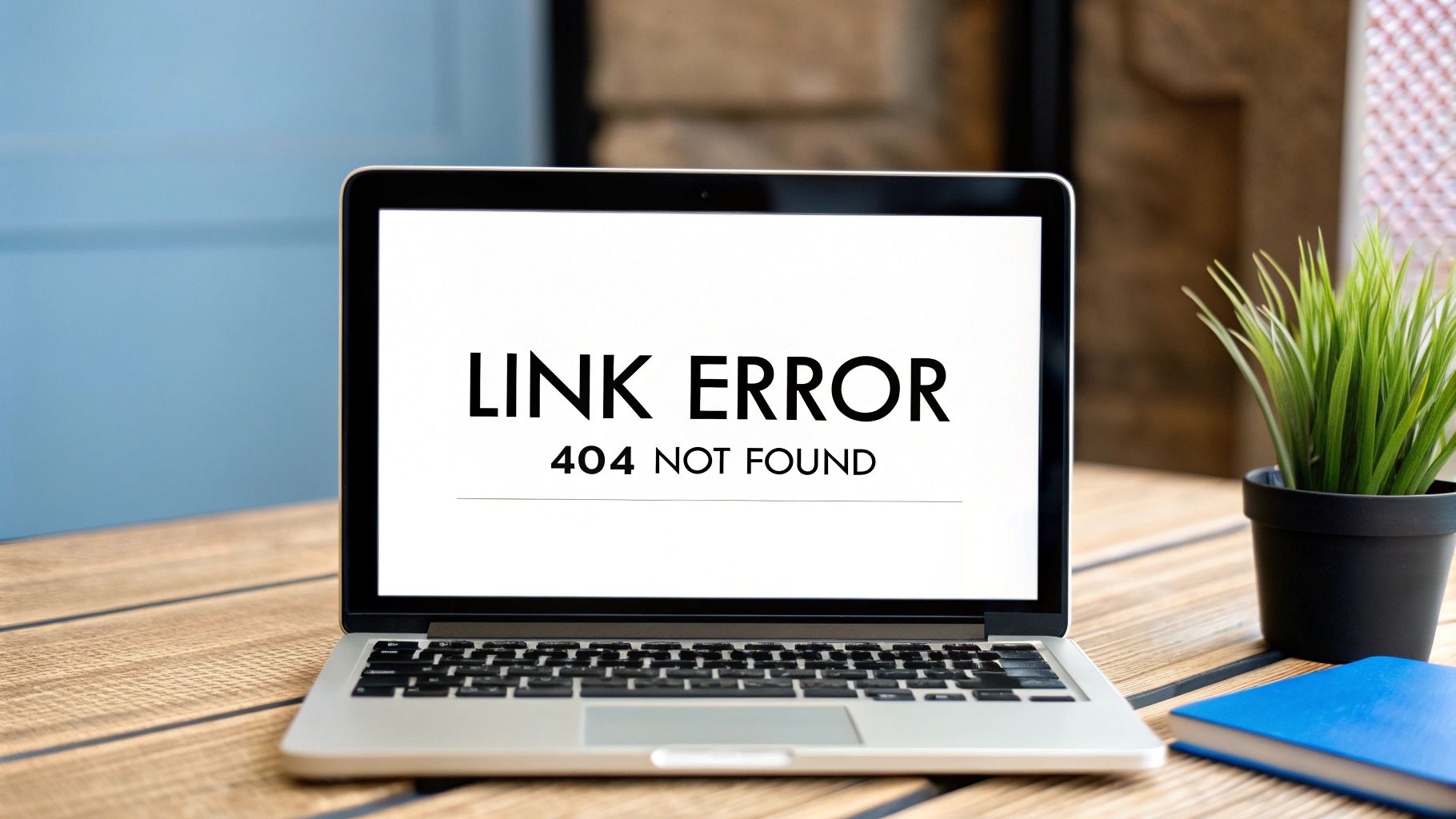Understanding What An X (Twitter) URL Actually Is (And Why It Matters)

An X URL (formerly known as a Twitter URL) is simply a web address that points to content on the X platform. This content can be anything from individual posts and user profiles to hashtag pages and trending topics. Understanding these URLs is vital for a successful social media strategy.
Knowing how to construct and share X URLs effectively can significantly boost your content's visibility and reach. This involves understanding the shift from twitter.com to x.com. Even though the platform has rebranded, backward compatibility ensures your old Twitter links still work.
This smooth transition is essential for maintaining information flow and access to existing content. Plus, understanding an X URL's structure provides valuable insights into how the platform organizes its vast network of users and conversations.
When discussing what an X (Twitter) URL is—a web address for a specific post, profile, or page—it's interesting to consider the sheer volume of links generated daily. As of 2025, X (Twitter) boasts over 500 million monthly active users.
With an estimated 350,000 posts sent every minute, this translates to roughly 504 million posts daily. Assuming each post has a unique URL, the platform generates them at an incredible rate. Find more statistics here: Twitter User Statistics.
This massive volume underscores the platform's dynamic nature. It also highlights how important it is to understand how these links contribute to the global conversation. You might also be interested in this article: What is Link in Bio?.
Why Understanding X URLs Matters
The structure of an X URL acts as a roadmap to specific content. Each part, from the domain name to unique identifiers, plays a crucial role in directing users. This knowledge allows you to navigate the platform efficiently and craft URLs strategically for your own content.
For example, knowing how to create a permalink for a specific post allows for easy sharing. Furthermore, analyzing X URLs can reveal insights into user behavior and content trends. By tracking which URLs are shared and clicked, you can better understand audience preferences.
This data can then inform your content creation and sharing strategies, leading to increased engagement. So, understanding X URLs isn't just about finding information; it's about using that knowledge for greater impact.
Decoding Twitter URL Structure Like A Digital Detective
Every Twitter URL, now often an X URL, tells a story. Understanding this story gives you a strategic advantage on social media. This means knowing the basic structure of a Twitter URL and how it's changed. A standard profile URL looks like this: twitter.com/username (or, now, x.com/username). This simple format takes users to a specific profile page. But there's more to these URLs than first meets the eye.
The following infographic shows the parts of a standard profile URL and how to access and share it:

As you can see, the structure is simple and easy to share. This helps people find and connect with profiles, making the platform more interactive. Besides profile URLs, there are other, more complex URL types.
Dissecting Tweet Permalinks
Individual tweets have unique URLs called permalinks. These include the username and a unique number that identifies the tweet. This lets you link directly to a specific tweet. This is useful for sharing specific information, referencing past discussions, or highlighting announcements.
Hashtags and Search Queries
Hashtag searches create distinct URLs, allowing you to follow topics. These usually include the # symbol followed by the keyword. Similarly, search queries with multiple keywords and filters have unique URLs. These help with tracking trends, researching competitors, and monitoring brand mentions.
Navigating Twitter Threads
Threads, a series of connected tweets, add another layer of complexity. Each tweet in a thread has a permalink, but the first tweet anchors the entire thread. Understanding this helps you manage discussions and engage with multi-part content. The link you share depends on whether you want to highlight the whole thread or a specific tweet.
The X Factor: How Platform Changes Affect URLs
The rebranding to X introduced the x.com domain. However, backward compatibility with twitter.com links is key. Older tweets and profiles are still accessible. This maintains the platform's archive. Understanding the x.com structure is important for future content strategy.
Why URL Structure Matters for Your Content Strategy
Understanding Twitter URL structures is a strategic asset. It helps you:
- Share specific content effectively
- Troubleshoot broken links
- Analyze audience interactions
- Understand content performance and user behavior
By mastering these details, you can navigate the platform better and optimize your content. This creates a more effective social media presence. For Shopify merchants optimizing their link-in-bio strategies, this is especially useful. They can link their X presence directly to their stores. Learn more about effective bio link strategies: Best link in bio apps.
To summarize the different URL types and their uses, see the table below:
Twitter URL Types And Their Strategic Applications
Complete breakdown of Twitter URL formats and how to leverage each type effectively
| URL Type | Structure Pattern | Real Example | Strategic Use Case |
|---|---|---|---|
| Profile URL | twitter.com/username or x.com/username |
twitter.com/elonmusk |
Finding and sharing specific user profiles |
| Tweet Permalink | twitter.com/username/status/tweet_id or x.com/username/status/tweet_id |
twitter.com/elonmusk/status/1720900539595575748 |
Sharing a specific tweet, referencing past conversations, or evidence |
| Hashtag Search | twitter.com/search?q=%23keyword or x.com/search?q=%23keyword |
twitter.com/search?q=%23AI |
Following conversations and trends around a specific topic |
| Search Query | twitter.com/search?q=query or x.com/search?q=query |
twitter.com/search?q=artificial%20intelligence%20-chatgpt |
Tracking complex search queries and monitoring discussions |
| Thread (Initial Tweet) | twitter.com/username/status/tweet_id or x.com/username/status/tweet_id (same as permalink) |
twitter.com/TwitterSupport/status/1714728947971657873 |
Sharing the starting point of a threaded conversation |
This table provides a clear overview of the different URL structures on X (formerly Twitter) and how they can be used for different purposes, from sharing individual tweets to tracking broader trends. Understanding these differences allows for a more strategic approach to content sharing and platform navigation.
How Twitter URLs Connect Global Conversations

Twitter, now X, URLs are more than just links. They're the connections that create real-time global conversations. These digital threads allow information to spread quickly, from breaking news and viral trends to worldwide cultural moments. This interconnectedness has changed how we consume and share information. A single tweet, amplified by its URL, can spark discussions and shape public opinion around the world in minutes.
The Global Reach of Twitter URLs
The strength of Twitter URLs is their ability to go beyond geographical limits. A journalist, for example, can instantly share a breaking story with a global audience, skipping traditional media delays. This speed is especially important in crises, allowing information to spread quickly and potentially saving lives.
Marketers also use Twitter URLs to connect with specific audiences in different regions, promoting products and building international brand recognition.
Twitter URL Usage in Major Markets
In major markets like the United States, Japan, and the United Kingdom, Twitter URLs are deeply woven into everyday digital life. The United States has the largest number of Twitter users—over 100 million as of 2025, representing roughly 17% of all users globally. Japan comes next with almost 70 million users, while the UK has about 24 million. This widespread use shows how important the platform is as a communication tool. More detailed statistics can be found here: Twitter User Statistics.
Cultural Nuances and URL Engagement
How people interact with Twitter URLs isn't the same everywhere. Cultural differences affect how users engage with content, the types of URLs they share, and when they're most active online. Understanding these differences is key for effective communication. A successful marketing campaign in one country might not work in another because of different online behaviors and preferences.
How integrated the platform is into daily life also varies between cultures. In some areas, Twitter is mainly a news source, while in others it's for social interaction and entertainment. This impacts the types of content that become popular and how URLs are used. For more insights on link strategies on social media, see our guide on Instagram bio links.
The Ripple Effect of a Viral Twitter URL
It's interesting to see how a Twitter URL can go from an initial post to a global phenomenon. A single tweet with a powerful message or captivating image can quickly gain traction as its URL gets shared and reshared across networks. This creates a ripple effect, boosting the original message and potentially reaching millions of users within hours. This ability to spark viral trends and global conversations demonstrates the transformative power of Twitter URLs in our interconnected world. These seemingly simple web addresses have changed how information spreads and conversations happen globally.
The Psychology Behind Twitter URL Engagement
Clicking a link on Twitter, now often called X, is more than a simple click. It's the result of a thought process, influenced by everything from personal taste to current trends. Understanding what makes people click those URLs is important for anyone who wants a wider audience. This section explores these hidden factors and offers practical tips to boost your URL engagement.
The Split-Second Decision: To Click or Not To Click
When someone sees a URL on Twitter, they quickly decide whether to click it. This decision depends on several factors. One key factor is the perceived value of the content. Does the link promise useful information, entertainment, or a chance to connect with others?
How the URL looks also matters. A short, clear link with an interesting preview image is more appealing than a long, messy one. Trust in the source also matters. People are more likely to click links from accounts they know and respect.
The Power of Social Proof: Why We Share and Retweet
Sharing and retweeting expand a URL’s reach, making it a powerful way to spread information and ideas. But sharing is a more complex decision than just clicking. The way people access and share URLs on the platform differs across age groups and family statuses. This shows how diverse the audience on Twitter (X) really is. In 2025, 38% of X users are between 25 and 34 years old, a key demographic for digital engagement and content creation. Also, 39% of users are parents, highlighting the variety of people using Twitter URLs daily. Find more detailed statistics here: X User Statistics.
Social proof is a big reason why people share. Seeing others interact with a URL—through likes, retweets, or comments—makes it seem more valuable and encourages more sharing. This is why trending topics spread so quickly.
Timing Is Everything: Peak Sharing Windows and Content Release
Knowing when to share your Twitter URL is as important as knowing what to share. Understanding your audience’s online habits is key. Think about their time zones and daily routines. Tweeting during rush hour or lunch breaks might get you more views.
Emotional Triggers and Viral Phenomena: Why Some URLs Take Off
Some Twitter URLs become more than just links; they become cultural moments. These viral URLs often tap into strong emotions, like humor, anger, or inspiration. Learn more in our article about creating clickable links in your bio. Twitter URLs can start conversations, and it's worth exploring which online actions are worth tracking: social behaviors to track and reward. These emotional connections drive engagement and encourage widespread sharing. Understanding these emotional dynamics can help you write better tweets.
By understanding the psychology behind Twitter URL engagement, you can move from simply posting links to strategically creating content that connects with your audience. This increases visibility and leads to meaningful interactions.
Mastering Twitter URL Sharing That Actually Converts

Sharing a Twitter URL, now often referred to as an X URL, involves more than simply pasting a link. It's about making that link work for you. Truly effective URL sharing requires smart strategies. Successful content creators and marketers employ techniques that transform ordinary links into powerful engagement tools.
This starts with understanding what a Twitter URL is and how to present it for maximum impact.
Crafting Click-Worthy URLs
The first step is making your Twitter URL enticing. A functional link isn't enough. Strategic formatting, optimized preview cards, and compelling presentation are key.
-
Strategic Formatting: Aim for short, clean URLs. A URL shortener like Bitly can help, but ensure it maintains your tracking data.
-
Optimized Preview Cards: Use attractive images or videos with your tweets. This creates a visually appealing preview that draws clicks.
-
Compelling Presentation: Write tweet copy that sparks curiosity. Clearly communicate the value users gain by clicking.
These techniques encourage clicks and make your URLs more shareable, boosting your content’s overall visibility.
Amplifying Reach and Timing Your Shares
Effective Twitter URL sharing goes beyond your profile. Strategic cross-platform promotion and timing are essential.
-
Cross-Platform Promotion: Share your Twitter URL on other platforms. Embed it in blog posts or email newsletters. This broadens your content's reach.
-
Strategic Timing: Analyze your audience's activity on Twitter. Schedule posts for when they're most engaged. This maximizes the number of people who see your URLs.
These methods significantly increase the reach of your message, creating more opportunities for engagement. You might also find this helpful: How to master TikTok links in your bio.
Tracking Performance and Maintaining Link Integrity
Sharing your Twitter URL is just the beginning. Tracking performance and cross-device functionality are crucial for long-term success.
-
Implement Tracking: Use analytics tools to monitor click-through rates and other engagement metrics. This data reveals what's working and informs future strategies. Tools like Google Analytics provide valuable insights.
-
Cross-Device Compatibility: Ensure your URLs function seamlessly on desktops, mobile devices, and tablets. This provides a consistent user experience, no matter how people access your content.
This ongoing monitoring and maintenance are vital, turning every shared URL into a growth opportunity.
Avoiding Common Mistakes
Common mistakes can undermine your Twitter URL effectiveness. Awareness prevents these issues and optimizes link performance. For instance, avoid misleading or clickbait language. This harms credibility and reduces click-through rates.
Let's look at some proven tactics for optimizing your Twitter URLs:
To help you understand these strategies better, let's look at some proven tactics in more detail:
High-Performance Twitter URL Optimization Tactics
Proven strategies for maximizing Twitter URL engagement and conversion rates
| Optimization Strategy | Implementation Method | Expected Impact | Best Use Case |
|---|---|---|---|
| URL Shortening | Use a reputable URL shortener that allows for custom branding and tracking | Improved aesthetics, trackable clicks, and shareability | Long or complex URLs |
| Preview Card Optimization | Include compelling images or videos in your tweets | Increased visual appeal and click-through rates | Content with visual elements |
| Compelling Call to Action | Craft tweet copy that clearly states the benefit of clicking | Higher engagement and conversions | Promotional content or special offers |
| Strategic Timing | Schedule tweets during peak audience activity | Maximized reach and engagement | Time-sensitive content or announcements |
By avoiding common pitfalls and implementing these strategies, you create a positive user experience. This encourages interaction and builds a loyal following. You’ve moved from random sharing to strategic promotion, turning each Twitter URL into a powerful tool for growth.
Solving Twitter URL Problems Before They Break Your Strategy
A strong presence on Twitter (now X) depends heavily on working URLs. Whether you're sharing a quick thought, promoting your newest blog post, or joining a trending conversation, a broken or poorly formatted Twitter URL can completely disrupt your social media strategy. This means understanding what a Twitter URL is and how to fix potential problems is crucial.
Common Twitter URL Issues and Their Fixes
Several things can cause problems with your Twitter URLs. Here are a few of the most common issues:
-
Broken Links: Sometimes, links that worked fine before suddenly break. This could be because the website is down, the content was deleted, or the URL structure changed. The solution is simple: double-check the URL in your browser. If the link is broken, you might have to find an archived version of the content or a different source.
-
Formatting Glitches: A poorly formatted URL not only looks unprofessional, but it might not work. Incorrect spacing, missing characters, or extra symbols can all break a link. Always double-check your URLs before posting to make sure they're copied and pasted correctly.
-
Suspended Account Links: Sharing a link to a suspended Twitter account will lead to a dead end. This can hurt your credibility. Always make sure the account is active before sharing.
-
Regional Restrictions: Some content is geographically restricted. This means users in certain locations can't access it. If you have a global audience, think about using a URL shortener with analytics. This lets you see where your audience is and spot potential access problems.
-
Platform Updates: Changes to the Twitter platform can affect how URLs work. Stay up-to-date on platform updates and adjust your strategy accordingly. To share your Twitter URLs at the best times, you might want to learn how to schedule a Twitter post.
Privacy Settings Affecting URL Sharing
Your Twitter privacy settings can also affect sharing and accessing URLs. If your account is private, only your approved followers can see your tweets and the URLs they contain. Regularly check your privacy settings to make sure they match your goals.
Recovering Lost Tweet Links
Losing a tweet with an important URL is frustrating. Thankfully, there are ways to recover lost tweets. Twitter's advanced search lets you search your own tweets using keywords or date ranges. You can also use third-party archiving tools to back up your tweets and their embedded URLs.
Preventive Measures for Long-Term URL Functionality
The best way to handle Twitter URL problems is to prevent them. Here are some proactive steps:
- Regularly check your shared links to find broken URLs early.
- Use a reliable URL shortener with link tracking and analytics.
- Use a consistent URL structure for your own website content.
- Keep up-to-date on Twitter platform changes and their impact on URLs.
By following these strategies, you can minimize disruptions and make sure your Twitter URL strategy stays effective. You might be interested in: How to master your link-in-bio strategy with top apps.
Looking for a powerful and visually appealing link-in-bio solution for your Shopify store? LinkShop offers a robust platform for shoppable link-in-bio pages. Check out LinkShop today: https://getlinkshop.com
